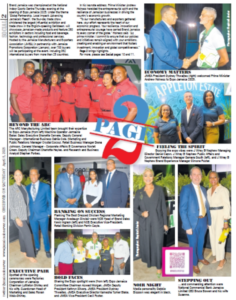
My Kingston — Justin Lane Briggs
What are your earliest memories of Kingston?
Landing and immediately hearing Barrington Levy’s She’s Mine playing on the hi-fi, and knowing I was ‘home’.
What’s the most memorable meal that you have enjoyed in Kingston?
Jerk chicken at Scotchies, probably, followed by brunch at Terra Nova, where I especially loved making a big pile of all the different salads.
What would you do if you were mayor of Kingston for a day?
Throw a massive reggae and tiki party to celebrate unity and love in the community.
Plan a perfect lost weekend to The Rock that won’t require a liver transplant.
Fly into Montego Bay and enjoy Micheladas on the beach with my girlfriend, ride into Trelawny and visit my friends at Hampden Estate! Cruise south and visit Kingston to catch the reggae venues and music stores, and enjoy the chalice — didn’t you say to give my liver a break?
What’s your preferred ice composition and style for a winning booze concoction?
It really depends on the drink. Some drinks want to dilute and open up further and further, with powerful flavors that stretch and breathe as they water down — for those, I want some crushed ice. Some drinks are powerful short drinks that need a little extra elbow room as they sit in my glass — for those, I want a big, beautiful rock. Sometimes I don’t want ice at all, and the drink should be enjoyed quickly, while it’s ‘still laughing at you’, as the late cocktail inventor, master mixologist and Harry’s New York Bar, Paris owner Harry MacElhone would say.
Describe the relationship between the produce market and the bar counter, in your pursuit of terroir.
My background in cocktailing is rooted in fresh produce. Great mixed drinks are like any culinary pursuit: the quality of your output is based on the quality of your ingredients. It’s not just healthier and more environmentally sound, it also tastes better. And, it’s often cheaper too. I also enjoy the way market produce keeps the season and the place front and centre. It makes sense to use what’s coming out of the ground wherever you are and whenever you are making it, just like you might in the kitchen. There are patterns and seasons to life for a reason, and it makes sense to be mindful of them.
Create a portrait of the Big Apple in five cocktails.
Start with a spritz in Central Park; then have a mezcal margarita in Brooklyn; a Jungle Bird on the Coney Island boardwalk; a Boilermaker on Staten Island; and finish with a martini or a Manhattan in midtown, of course.
We hear there’s a tiki revival. Give us your take.
It’s a complex subculture that took shape with American sailors returning from the Pacific Theatre after World War II, but transformed rapidly into kitsch. There’s always been an undercurrent of racial insensitivity to it as well. The current movement, at its best, seems to be interested in dismantling the racial components of tiki while embracing and exploring the genius at the core of its culinary legacy. Basically, ideas surrounding the ‘split base’ concept: the notion that sometimes four or five rums can achieve what just one cannot. I’m talking flavour here, not intoxication. It’s also just fun to work on big, complex drinks that pair spice — like pimento — and herb — like absinthe — with rum and fruit, with the explicit intention of making powerful flavours and strong drinks. But maintaining balance is the key. Historic tiki was not always a saccharine sugar bomb, and the best of the modern revival are also not necessarily sweet.
In the preservation of any craft, what must always remain front and centre?
Balance and technique. Humility and patience. You need to devote time to practise and, most of all, knowledge!
When you need to pull yourself together, what’s the drink that sets you straight?
A quick daiquiri. In New York, when you shoot a classic daiquiri — just rum, lime and sugar, shaken — we call it a Snaquiri. Sometimes, that’s all I need to get back on the horse!
























